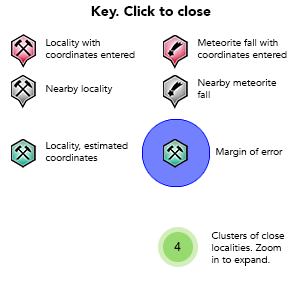Mikhaburra Gold Mine (Holden's Find), Peak Hill Goldfield, Meekatharra Shire, Western Australia, Australia

| Latitude & Longitude (WGS84): | 25° 56' 3'' South , 118° 33' 39'' East |
|---|---|
| Latitude & Longitude (decimal): | -25.93420,118.56105 |
| GeoHash: | G#: qekk3yvd2 |
| Locality type: | Mine |
| Köppen climate type: | BWh : Hot deserts climate |
No historic information could be found under the name Mikhaburra, although it is listed under this name on modern maps. Historic information was found under the name Holden's Find. The location is 6 kilometres north-west of the Cashman Mine. It consists of a small amount of battery sands (most cyanided in the late 1930's), a group of shafts running west north-west to east south-east, and what appears to be a collapsed shaft or small pit. There is also a small group of shafts about 1 kilometre to the east (Winnett's lease). The field has produced 7300 ounces of gold.
It was discovered by Alfred Holden at the beginning of September 1913, after testing some quartz outcrops. Floaters (gold nuggets) were found in lines roughly matching the reefs underneath. Prospectors from nearby Cashman and Ruby Well rushed to the scene. Holden himself had pegged an 18 acre lease (The Woodrow) and was raising white quartz thickly impregnated with iron pyrites and gold. Adjoining this was Cashman and party, adjoining them W. Baker and Davis (The Junction), and then Marriott and Beaton's lease. These were all on what would become known as Holden's Reef. Whittaker, Legah and Fitzgerald had pegged a lease south-west of this, on a parallel reef, subsequently known as Whittaker No 1 Reef. The reef was described as laminated quartz showing faint secondary copper and strong veins of iron pyrites similar to Holden's Reef.
A lease called The Moa Bird by Freeman and party is also mentioned. By November 60 men were on the field with 16 leases pegged each either 18 or 24 acres.
Shortly after, government geologist, E de Courcy Clarke visited the location. A little under the surface at Holden's is 3 to four feet of yellowish cement (hardened clay), and the surface is strewn with quartz and limonite boulders. As little work had been done below this, not much is said about the geology in his report. Later reports state the deposit is hosted in chlorite schist of the Narracoota Formation. There are gold bearing quartz veins emplaced along a shear zone.
Shortly after discovery, the Ruby Well Development Syndicate and Ruby Well Option Syndicate had employed 30 men to prospect several of the claims. The Mararoa Company joined soon after. Some of these companies were based in Adelaide. One of the Ruby Well companies was erecting a 5 head battery on the Whittakers lease in 1915.
The companies soon left after discovering poor values, however several of the prospectors persisted. In 1916, 14 are still on the field, many from the time of the discovery.
Subsequently the Waterloo G.M. came to the fore. Crushings are reported in 1917 and 1918 for the mine. In 1923 it was employing 12 men, had a 5 head battery, was conducting development work to 150 feet down. The mine must have been abandoned as in 1927 someone is reported to be trying to un-water the old mine, however by 1929 the mine is under exemption.
J.E. (or A.E, or E.K depending on the source!) Garland had 10 men employed and was un-watering the old Waterloo mine, and cyaniding the sands from the battery operations generated years before. This occurred between 1937 to 1940.
Commodity List
This is a list of exploitable or exploited mineral commodities recorded at this locality.Mineral List
12 valid minerals.
Rock Types Recorded
Select Rock List Type
Alphabetical List Tree DiagramRegional Geology
This geological map and associated information on rock units at or nearby to the coordinates given for this locality is based on relatively small scale geological maps provided by various national Geological Surveys. This does not necessarily represent the complete geology at this locality but it gives a background for the region in which it is found.
Click on geological units on the map for more information. Click here to view full-screen map on Macrostrat.org
| Quaternary 0 - 2.588 Ma ID: 921243 | colluvium 38491 Age: Pleistocene (0 - 2.588 Ma) Description: Colluvium and/or residual deposits, sheetwash, talus, scree; boulder, gravel, sand; may include minor alluvial or sand plain deposits, local calcrete and reworked laterite Comments: regolith; synthesis of multiple published descriptions Lithology: Regolith Reference: Raymond, O.L., Liu, S., Gallagher, R., Zhang, W., Highet, L.M. Surface Geology of Australia 1:1 million scale dataset 2012 edition. Commonwealth of Australia (Geoscience Australia). [5] |
| Paleoproterozoic 1600 - 2500 Ma ID: 3184366 | Paleoproterozoic sedimentary and volcanic rocks Age: Proterozoic (1600 - 2500 Ma) Stratigraphic Name: Glengarry Group Comments: Naberru Basin Lithology: Mafic volcanic rocks; basalt; greywacke,iron formation,shale,sandstone,conglomerate Reference: Chorlton, L.B. Generalized geology of the world: bedrock domains and major faults in GIS format: a small-scale world geology map with an extended geological attribute database. doi: 10.4095/223767. Geological Survey of Canada, Open File 5529. [154] |
Data and map coding provided by Macrostrat.org, used under Creative Commons Attribution 4.0 License



